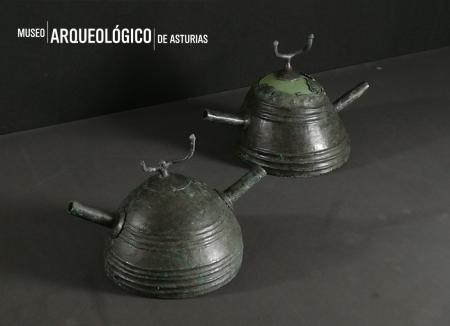Conferences, Workshops and Seminars
|
PRESENTATION OF TWO BRONZE HELMETS IN A CAVE IN PICU LAS TORRES (RIBADESELLA)

PRESENTATION OF TWO BRONZE HELMETS OF A CAVE IN PICU LAS TORRES (RIBADESELLA), PROBABLY FROM THE 7TH CENTURY B.C. From 19 May, the museum's permanent exhibition will feature two new exceptional pieces. These are two bronze helmets found in the cave of Picu Las Torres in Ribadesella which, due to their extreme rarity, are unique pieces in the peninsular weapons repertoire. Description Two hemispherical helmets made on a bronze plate with a double symmetrical socket for plumes or antlers and a crest with appendages ending in a button, all of them cast in leaded bronze and fixed by rivets. Both helmets are decorated with bands of embossed grooves. Despite their formal similarity, the helmets were made by different craftsmen at a period that could be broadly dated to between the Late Bronze Age and the Early Iron Age. They were deposited at the site of their discovery more than 2,500 years ago, probably around the 7th century BC, a historical period characterised by the appearance of the first castros (fortified settlements) in Asturias. The tubular appendages for the insertion of antlers recall the image of helmeted warriors on Late Bronze Age stelae from the Southwest and other similar or older representations from the eastern Mediterranean, from Egypt to Sardinia. Its crest with curved appendages resembles those that characterise Asturian antennae daggers. Findings and scientific study Located in December 2020 inside the cave, the Directorate General of Cultural Heritage of the Principality of Asturias and the Archaeological Museum of Asturias promoted an urgent intervention to assess the archaeological potential of the site and provide data related to the nature and intentionality of the deposit. The results of these studies point to a ritual deposit, which in principle does not appear to be related to funerary practices, inside a grotto whose ceremonial use dates back to prehistoric times. Ceramic and bone materials have also been found, and specific studies are being carried out on them. Before being cleaned and consolidated, the metal pieces were taken to the facilities of the Laboratory of Electron Microscopy and Microanalysis of the Institute of History of the Higher Council for Scientific Research, where an exhaustive study of their components was carried out. These helmets, together with the Sobrefoz sword from the Late Bronze Age (11th century BC) shown in the same display case, represent the true prestige objects of the warrior panoply during the Early Iron Age. Their rarity, shape and excellent state of preservation make them true jewels of the museum. |


